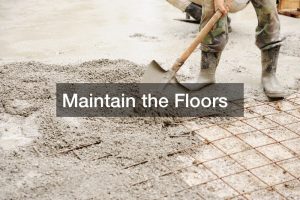Whether you’ll use your residential barn for storage, crafting, grain, or actual animals, you’ll need to know how to maintain it. There’s nothing more dangerous than letting a pole barn structure go without proper checkups. You need to be a responsible property owner, so let’s discover some great tips on how to keep your barn in great shape.

Maintain the Floors
Barn floors need to be durable and resistant because this area of your property will see a lot of foot traffic. It’ll only be worse if you have animals inside. Therefore, you must choose the best flooring and consider several materials. For example, many prefer to keep it as a dirt floor, the cheapest option. However, it’ll still require maintenance if you don’t want a muddy or smelly barn.
Consider choosing other options, like concrete or rubber mats, that may cost a little more. Many barn owners also choose waterproof flooring. Your location will factor in your flooring options, but safety is the main aspect to consider. You don’t want to slip or cause animal injuries. Concrete is a common choice for barns because it doesn’t get too dusty or moist.
It’s easily cleaned, and it’s cost-effective. Popcorn asphalt is another great material, especially because it’s cheaper than concrete. It’s durable and allows water to seep through to the soil below. Remember to consider how you’ll maintain and replace each flooring if something happens. That’ll help you narrow down the choice.

Upgrade Your Mill Lining
Many people still have barns for their grain businesses, meaning they often also have mills to process their products. Consider upgrading the mill lining to keep it in optimal shape. The lining helps the mill move forward effectively with the right gripping force for better grinding. It gets worn over time, and it’s easier to replace than to force the mechanism to work harder for the same result.
You should consider other options, like changing to a better design. An optimized grinding mill liner will maximize efficiency and reduce wear and tear. In many new models, you can control the charge motion to reduce the impact but still get the best results without exerting as much effort. Naturally, a new one can be expensive.
However, you have to consider the long-term investment it can be. If you bought a home that already came with an old barn and a mill, you may have no idea when it was first purchased. Older machines can be repaired or last for decades without problems, but newer technologies make things a little easier. Consider upgrading to keep your barn in great shape. Despite what you may think, customers can tell the difference in grinding.

Monitor and Repair Foundation Issues
Barns are usually built directly on the soil without much foundation work. However, that can become a problem depending on your use of this structure. Many people have drainage issues, which can later lead to erosion problems. Frost can also affect the surface. In that case, you’ll have to call erosion control services to develop better solutions so it doesn’t happen again.
Even if your barn has a foundation, it won’t be as durable as the one for your house. Some people don’t realize how their field drains can move through their property due to groundwater flow. This water can freeze below ground, causing significant issues for unheated foundations or those not secured on ground level. Concrete floors and stone walls can buckle due to the freezing and thawing of water. Heaving will put pressure on the walls.
Additionally, parts of the structure may be in contact with this soil, absorbing the water and causing rot over time. Therefore, drainage is one of the main things you must consider when keeping your barn in great shape. A proper system will protect your animals or your stored items. You may need experts to inspect before moving forward with repairs, so it’s worth putting in a call and following expert recommendations.

Upgrade Panels
The walls of your barn won’t be the same as those in your main house. Usually, the structure will consist of different panels. You may need panel upgrades for several reasons. For example, you may plan to get some farm animals, but they’ll require insulation. That often means moving panels around, installing the weather-resistant material, and putting back new panels. You probably won’t need a crane rental unless your barn is large and tall.
Tower cranes are only used in industrial settings, but a smaller one could help get the job done quicker, as long as you get people who know what they’re doing. Some homeowners find themselves with an old barn with rotting panels, which must be replaced before using this building. Rusting panels can break easily, leading to major risks.
You should also check for mold within panels, which are usually wooden. Anything can affect this material, and you shouldn’t spend any significant amount of time inside a barn with so many issues. Furthermore, consider upgrading the electrical panel if you want to use power tools in the barn. You may need more wattage just to be safe.
Upgrade Security
You’ll need a proper security system for your barn, whether you plan to keep animals, produce, or power tools inside. A central alarm monitoring system could help keep everything safe, and the best part is that you don’t need to extend your internet service. You can get cameras that capture live feeds without needing to be online.
Barn cameras are perfect for video surveillance so that you can keep track of your horses or products. Some have internet options, but many can be wired as regular CCTV. However, investing in extending your Wi-Fi to reach the barn is a good idea so you can check everything straight from your phone.
Aside from cameras, you’ll need to ensure the doors can be bolted adequately at night. Some animals have been known to learn how to open simple locks and escape. Making sure that everything and every animal inside is safe should be your main priority and one of the many ways you can keep your barn in great shape.
Maintain Ventilation
Barns aren’t supposed to have as many windows as a home, but air is essential if you want to work inside it or house farm animals. Ventilation will help you maintain the temperature, which can get hot in the summer. Some people consider an industrial furnace for the winter, but it may not be necessary if you have upgraded other aspects of this structure, like insulation.
Making sure there’s good ventilation will help you get control of the temperature when the weather is harsh. Consider adding vents or fans to increase airflow. Fans on the roof are great for cooling down the area. However, you should also look at other ventilation systems, like ridge and gable vents or cupolas. These options will depend on the size and shape of the structure, so talk to an expert and get an on-site consultation.
Airflow is not only for the comfort and safety of your animals and products. It’ll also help prevent moisture, which leads to mold and mildew. Barns can get dirty and smelly due to excrement, but letting air flow will help reduce the pungent smell until you can clean up. Don’t let things get too stuffy.
Check the Structure
Aside from upgrading the flooring and the paneling, you’ll need to ensure the entire structure is adequately in shape. Most people inherit or buy an older property with a residential pole barn and need to ensure that everything is solid before using it. You probably won’t have to deal with industrial pipe products because pole barns are simple but still need proper maintenance.
Check the ridgeline from a distance and consider if it’s straight or sagging. Unfortunately, any kind of sagging will require repairs. Go inside and check if the roof is sagging, as it can often mean that the rafters have bowed. Call a roofing company if that’s the case. It shouldn’t be as expensive as home roofing repairs, but it’ll still be pricey. However, it’s an important investment.
You must check the exterior sides and corners to see if they’re vertical. The barn’s gutters are also essential because their main function is redirecting water so it doesn’t absorb into the foundation and siding. Make sure they aren’t bent, clogged, or damaged. It’s also smart to check that the barn door can fully open and close without hitting the floor underneath. Fix the paint and the windows, too.
Eliminate Pests
A major issue for barns is that pests can easily hide and are often unnoticed. You must keep them away from farm animals because they can be spooked. Also, rats could contaminate their food. Furthermore, other pests can mess with your products and your work. They chew on electrical wires, pee on everything, and damage your things.
Eliminate and prevent any more from returning. Check for possible entry points in your barn. Always leaving the door and windows closed is a good start, but there could be holes in the panels where they crawl in easily. Therefore, shut the door, turn off any lamp, and check for light points inside. Walk around and see what areas will need to be covered to prevent pests from returning.
You can cover those holes with weather stripping, caulking, sealant, etc. You should also use caulk around vents, drains, and pipes. If you bought or inherited an old barn, call pest control services for an inspection and a thorough extermination before you start repairs. You can also find specialized builders who’ll help you upgrade your barn, considering that critters want to get inside. Never underestimate the power of expertise in any construction work.
Organize and Clean the Interior
The best way to keep your barn in great shape is by organizing it properly once all the repairs are finished. You want a natural flow for whatever you want to do in it. If you’re using it as a crafting area, keep your workstation clean and have bins and rags you can use in case you want to get rid of dust and wipe your hands. If you’re storing things, you must put them properly so they don’t fall and break.
For animals, you’re going to need more work. People set up stalls in their barns, a place for the feed to be stored and a place for hay. Once you organize everything adequately, you can make cleaning schedules. Obviously, a barn with livestock will need to be cleaned daily because animals poop, and you don’t want excrement to accumulate.
You’ll also need to wash the floors to prevent stains and smells from lingering. If you see water puddles, get them dry as soon as possible and let air flow to avoid issues later. Remember to keep things decluttered even if you’re storing a lot of stuff. You can buy caddies or cabinets for storing your boots, horse saddles, bridles, straps, tools, etc. Food should always be in closed bins to prevent any pests from getting in.
Install Wainscot
Consider one more aspect to protect your barn: wainscot. This material is a strip of steel around four feet tall that is usually placed at the lower part of a pole barn. It’s not used or required everywhere, but it’s an extra layer of protection for your structure. Many barn owners choose a color that contrasts with the outer barn paint. They tend to match it to the roof.
It has several benefits, including preventing dents, dings, and harm to the siding. The wainscot becomes the main buffer of the outer structure. Furthermore, it makes a pole barn look much better. It’s a great way to add curb appeal without spending that much money. It can be replaced easily once it gets too damaged, and it’s cheaper than replacing the barn wall or the entire siding.
Whatever extra protection you can add that doesn’t cost that much money is a good idea. There’s a good chance that barns will get dinged through farm labor or even just children throwing around a ball. If you’re going to spend a significant amount of money fixing it up, you better protect your investment.
Now that you understand these tips on how to keep your barn in great shape, it’s time to take action. Start with the basics, like cleaning and clearing the clutter. Take things one step at a time so you don’t get too tired or overwhelmed. Afterward, establish a schedule for proper maintenance so it can always remain perfect.



